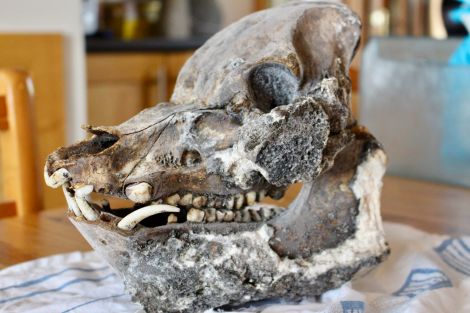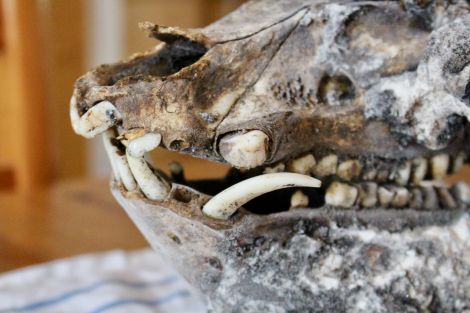Community / Experts looking into whether skull is from extinct Shetland grice
AN ANIMAL skull recently unearthed in the Nesting area is being examined to determine whether it is from the extinct Shetland grice pig.
The skull, found underground while a trench was being dug for drainage, features what appears to be pieces of fat, as well bristles.
The Shetland grice was an indigenous pig, complete with tusks, which was common in the isles for centuries but later became extinct, with reports of it being last known in Shetland in the late 1800s.
There are no remaining examples of a full Shetland grice skull.
Edinburgh-based Dr Andrew Kitchener from National Museums of Scotland, however, said judging by photos it may unlikely to be from a Shetland grice – with question marks over the size of its snout.
There is a possibility, he said, that it could be the skull of a pig with grice ancestry.
The skull was initially found a few weeks ago by a friend of Tom Jamieson working on an old house.
Jamieson was also working in the area and noticed the dug up skull, covered in mud looking like a “cannonball”, after it was set aside on a stone wall for a couple of weeks.
Some of the teeth were sticking out of the mud, though, sparking Jamieson’s interest.
He helped to remove the outer layers, revealing the skull underneath.
“I saw the teeth in it and then I realised straight away what I thought it was,” Jamieson said.
“I’ve found jawbones before but never a complete skull.
“We were finding fat residue and all this organic material on it – you can even see the bristles on him as well.”
He said it would be an “amazing” find if it did turn out to be the skull of a grice.
Museum staff, both locally and nationally, are now involved in figuring out the skull’s origins.
Become a member of Shetland News
Dr Kitchener, who is the principal curator of vertebrates in the department of natural sciences at National Museums Scotland, said he is unsure at this stage whether it is indeed the Shetland grice.
“It is very difficult to know whether any pig skull found in Shetland is a grice, because as far as I know there are no preserved specimens for comparison,” he said.
“However, from the few descriptions that do exist, it would seem to have had a long snout similar to the reconstruction of a grice in the Shetland Museum.
“If so, then this skull is unlikely to be from a grice, because the snout is very short.
“It does look more similar to the skulls of modern breeds of pig.
“Of course the last grice were probably interbred with modern pigs and so perhaps a genetic analysis of this skull could reveal whether it had grice ancestry.”
More measurements of the skull, which is currently wrapped in tinfoil in Jamieson’s freezer, are set to be taken this weekend.
A model of a grice was made for the opening of the Shetland Museum in 2007, but it was based on documents and historical records.
The grice was domesticated and kept for food, but it was said to have had an angsty character – with reports of it attacking lambs.
They are said to have been introduced to Shetland by Viking settlers.
Local man Neil Anderson, meanwhile, who is a keen collector of skulls, said it would be a “unique” discovery if it turned out to be a Shetland grice.
He said they were mostly kept in the hills, with plenty of regulations around them.
Anderson added that grice bristles were used to strengthen rope.
Become a member of Shetland News
Shetland News is asking its many readers to consider paying for membership to get additional features and services: -
- Remove non-local ads;
- Bookmark posts to read later;
- Exclusive curated weekly newsletter;
- Hide membership messages;
- Comments open for discussion.
If you appreciate what we do and feel strongly about impartial local journalism, then please become a member of Shetland News by either making a single payment, or setting up a monthly, quarterly or yearly subscription.


























































